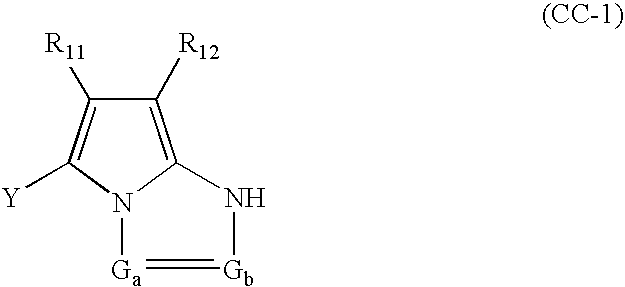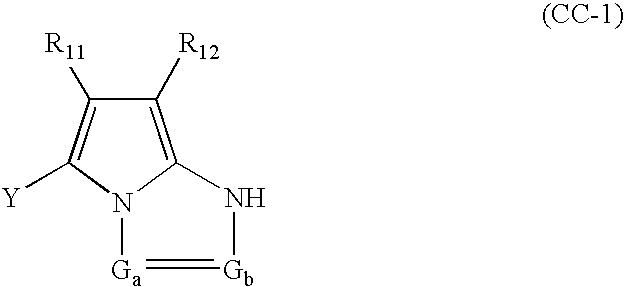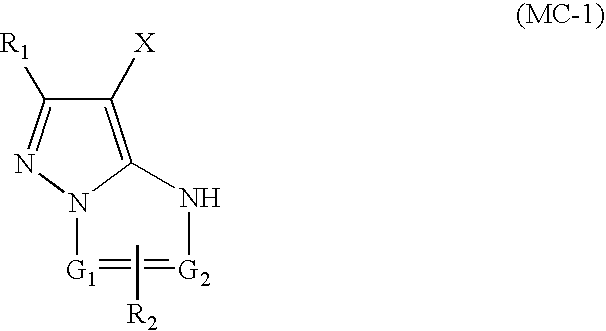Method of forming color images
a color image and color technology, applied in the field of color image formation, can solve the problems of unsatisfactory tone reproduction, difficult to reproduce exactly the same image quality, and inability to view, and achieve enhanced saturation and enhanced gradation reproduction
- Summary
- Abstract
- Description
- Claims
- Application Information
AI Technical Summary
Benefits of technology
Problems solved by technology
Method used
Image
Examples
examples
[0124]The present invention will be described specifically by examples, but the present invention is not limited to these.
example-1
[0125]A; Formation of an Original Sample
Preparation of a Silver Halide Color Photosensitive Material, Sample A101
Preparation of Triacetylcellulose Film
[0126]Triacetylcellulose was dissolved (13% by weight) by a common solution casting process in dichloromethane / methanol=92 / 8 (weight ratio), and triphenyl phosphate and biphenyldiphenyl phosphate in a weight ratio of 2:1, which are plasticizers, were added to the resultant solution so that the total amount of the plasticizers was 14% to the triacetylcellulose. Then, a triacetylcellulose film was made by a band process. The thickness of the support after drying was 205 μm.
[0127]Components of Undercoat Layer
[0128]The two surfaces of the triacetylcellulose film were subjected to undercoating treatment. Numbers represent weight contained per liter of an undercoat solution.
[0129]The two surfaces of the triacetylcellulose film were subjected to corona discharge treatment before undercoating treatment.
[0130]
Gelatin10.0gSalicylic acid0.5gGlyc...
example-2
[0199]The following silver halide color photosensitive material for use as an original, Sample C101, was prepared
Preparation of Sample C101
[0200](i) Preparation of Triacetylcellulose Film
[0201]Triacetylcellulose was dissolved (13% by weight) by a common solution casting process in dichloromethane / methanol=92 / 8 (weight ratio), and triphenyl phosphate and biphenyldiphenyl phosphate in a weight ratio of 2:1, which are plasticizers, were added to the resultant solution so that the total amount of the plasticizers was 14% to the triacetylcellulose. Then, a triacetylcellulose film was made by a band process. The thickness of the support after drying was 97 μm.
[0202](ii) Components of Undercoat Layer
[0203]The two surfaces of the triacetylcellulose film were provided with the following undercoating. Numbers represent weight contained per liter of an undercoat solution.
[0204]
Gelatin10.0gSalicylic acid0.5gGlycerin4.0gAcetone700mLMethanol200mLDichloromethane80mLFormaldehyde0.1mgWater to make1....
PUM
| Property | Measurement | Unit |
|---|---|---|
| sensitivity wavelength | aaaaa | aaaaa |
| sensitivity wavelength | aaaaa | aaaaa |
| thickness | aaaaa | aaaaa |
Abstract
Description
Claims
Application Information
 Login to View More
Login to View More - R&D
- Intellectual Property
- Life Sciences
- Materials
- Tech Scout
- Unparalleled Data Quality
- Higher Quality Content
- 60% Fewer Hallucinations
Browse by: Latest US Patents, China's latest patents, Technical Efficacy Thesaurus, Application Domain, Technology Topic, Popular Technical Reports.
© 2025 PatSnap. All rights reserved.Legal|Privacy policy|Modern Slavery Act Transparency Statement|Sitemap|About US| Contact US: help@patsnap.com



